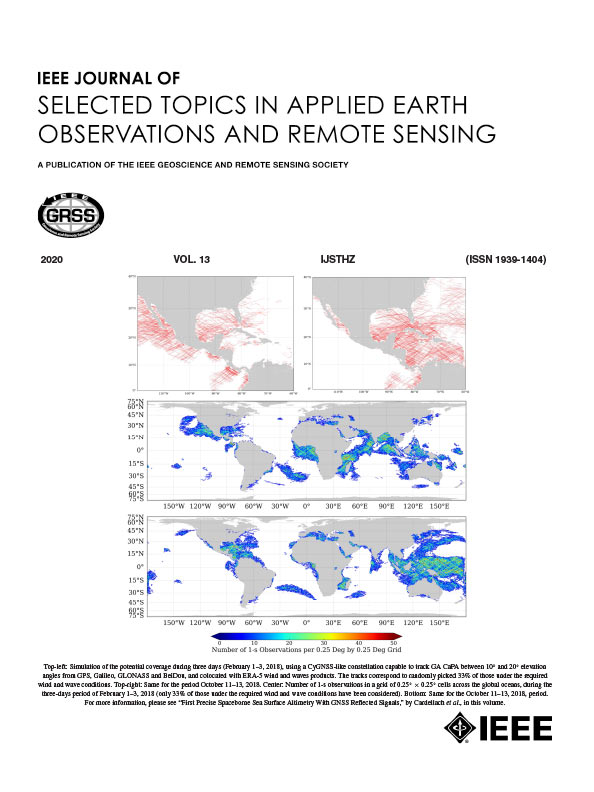基于频率特性的SAR目标识别方法
IF 5.3
2区 地球科学
Q1 ENGINEERING, ELECTRICAL & ELECTRONIC
IEEE Journal of Selected Topics in Applied Earth Observations and Remote Sensing
Pub Date : 2025-10-02
DOI:10.1109/JSTARS.2025.3617129
引用次数: 0
摘要
当前合成孔径雷达(SAR)自动目标识别(ATR)的研究表明,少量学习算法可以通过使用数百到数千个样本输入的训练范式获得优异的分类精度。然而,现有的方法忽略了雷达图像的频率特性,仅依靠像素描述符的相似性进行目标识别。为了克服这一限制,本文提出了频率特征引导网络(FCGN),这是一种明确为具有有限训练样本的SAR ATR场景开发的架构。首先,我们提出了一种分频特征提取器,丰富了目标的频率特征。此外,FCGN进一步集成了一个频域样本扩展器,这是一个用于生成频谱一致的伪样本的专用组件,增强了支持集的异质性,最终细化了潜在表示空间中的类分离边界。最后,我们提出了一种自适应频域匹配器(AFDM)。AFDM通过选取的频率分量计算样本间频域一致性,网络综合像素一致性和频域一致性来区分样本。对运动目标和静止目标采集识别数据集的严格评估表明,该方法优于现有方法。本文章由计算机程序翻译,如有差异,请以英文原文为准。
Frequency Characteristics Guided Network for Few-Shot SAR Target Recognition
Contemporary research in synthetic aperture radar (SAR) automatic target recognition (ATR) reveals that few-shot learning algorithms can attain exceptional classification accuracy through training paradigms employing several hundred to thousands of sample inputs. However, existing methods ignore the frequency characteristics in radar images and only rely on the similarity of pixel descriptors for target recognition. To overcome this limitation, this article presents frequency characteristics guided network (FCGN), an architecture explicitly developed for SAR ATR scenarios with limited training samples. First, we propose a frequency-separated feature extractor, which enriches the frequency characteristics of the target. In addition, FCGN further incorporates a frequency-domain sample expander, a dedicated component for generating spectrally congruent pseudosamples that enhance support set heterogeneity, ultimately refining class separation boundaries in the latent representation space. Finally, we propose an adaptive frequency-domain matcher (AFDM). AFDM calculates the inter-sample frequency-domain consistency through selected frequency components, and the network synthesizes the pixel consistency and frequency-domain consistency to discriminate the samples. Rigorous evaluation on the moving and stationary target acquisition and recognition dataset demonstrate that the proposed method surpasses current approaches.
求助全文
通过发布文献求助,成功后即可免费获取论文全文。
去求助
来源期刊
CiteScore
9.30
自引率
10.90%
发文量
563
审稿时长
4.7 months
期刊介绍:
The IEEE Journal of Selected Topics in Applied Earth Observations and Remote Sensing addresses the growing field of applications in Earth observations and remote sensing, and also provides a venue for the rapidly expanding special issues that are being sponsored by the IEEE Geosciences and Remote Sensing Society. The journal draws upon the experience of the highly successful “IEEE Transactions on Geoscience and Remote Sensing” and provide a complementary medium for the wide range of topics in applied earth observations. The ‘Applications’ areas encompasses the societal benefit areas of the Global Earth Observations Systems of Systems (GEOSS) program. Through deliberations over two years, ministers from 50 countries agreed to identify nine areas where Earth observation could positively impact the quality of life and health of their respective countries. Some of these are areas not traditionally addressed in the IEEE context. These include biodiversity, health and climate. Yet it is the skill sets of IEEE members, in areas such as observations, communications, computers, signal processing, standards and ocean engineering, that form the technical underpinnings of GEOSS. Thus, the Journal attracts a broad range of interests that serves both present members in new ways and expands the IEEE visibility into new areas.

 求助内容:
求助内容: 应助结果提醒方式:
应助结果提醒方式:


